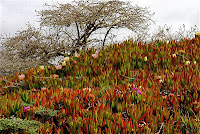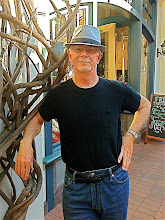In the Middle of Somewhere
I am pleased to introduce my first guest blogger, Carol, my wife, best friend and constant travel companion.
San Francisco – 250 miles
Los Angeles – 200 Miles
San Luis Obispo , a town of 44,000 residents located inland seven miles from the Pacific Ocean, is featured in Dan Buettner’s “Thrive” as one of the happiest places to live. What makes all these people so happy? I set out to find out.
Remember: You can click on any photo to see it full screen.

We caught the happy mood of San Luis Obispo early in our stay.
After a flight to Santa Barbara and a 90 minute drive up highway 101, my husband and I comfortably settled into a house in the historic Mill Street district , available through AirB&B. We had a first floor bedroom and bath and the use of the kitchen, living room and dining room. We were a short walk to downtown SLO. Off to explore the possibilities!
Dining Recommended were Buona Tavola, Luna Red, Big Sky Café and Novo. We chose Novo because it had patio dining that overlooked the creek and looked across at the Mission (of St. Louis Obispo) and the Museum of Art. And patio heaters for when the sun went down.
Shopping It was Friday night and the streets were bustling with activity. The usual mall destinations – Gap, Express, Victoria’s Secret, Abercrombie & Fitch were complemented by local shops and galleries. Young and old alike strolling the avenues.
Movies There are 3 cinemas in downtown and we arrived in the middle of the International Film Festival.
On the walk back we discovered we were a few blocks away from a supermarket and drug store. We stocked up on eggs, bacon, fruit, yogurt and Haagen-Daaz ice cream. We were happy.
The next day dawned sunny and warm, so we headed out for some exercise.
Hiking There are several areas for hiking right around town. There is a list on the city map that details length of time and difficulty level. Bishop’s Peak at 2 hours time and strenuous sounded like a challenge. Just past Foothills Boulevard on Santa Rosa (Route 1) , turn into the Highlands subdivision and head back to the trailhead. By the time we got up and back down, the hills were alive with hikers – from grandpas and grandmas to young couples toting toddlers to teens and college students. And it was strenuous, so these happy people must be in good shape.
As we left, we noticed that the campus of Cal Polytechnic was just across the highway, so we grabbed a sandwich at a student café and pondered our next adventure.

On the trail to the summit of Bishop Peak
Biking Of the five bicycle shops in town, Wally’s on Higuera near South Street was most likely to have bikes for daily rental. For $25 you get the bike, helmet, lock and a great map of all the cycling routes in the greater SLO area. This is a bicycle town – the routes go everywhere. We went to Avila Beach – a 16-mile roundtrip. Some of the route was on a frontage road next to busy 101 and some on a dedicated multi-use trail.
Beaches Avila Beach is the closest shore town to San Luis Obispo. Other options are Pismo Beach, Morro Bay, Cayucos and Cambria.
We cleaned up and walked back into downtown for dinner and a movie, feeling healthy and happy.
Just like Camelot, the rain held off until Saturday night. So Sunday started out cool and gray. Time for a coffee and the New York Times. On the south end of town, on Tank Farm Road near Higuera, there was a small farmer’s market selling local produce. There was also a Trader Joe’s for the rest of our grocery needs. What else do you need?
Wineries The Central Coast region is famous for its multitude of vineyards, so we visited a few tasting rooms. Just a few miles south of the city you can visit a dozen or so. We were lured in by a few. The major grapes are chardonnay and pinot noir. We also tasted grenache and syrah and riesling. The countryside is beautiful down here – you don’t even need wine to enjoy the views.

San Luis Obispo is nestled in the Central Coast wine country.
Art Our day was slipping away fast, we just had time to get a nice lunch at Big Sky and visit the Museum of Art. The current exhibits at the museum featured photographs of icons and legends by Michael Childers and unique Circus dioramas by Kathy de Palma.
A short stay but impressive in the amount of activities available. The most impressive feature? It could be the people…. They were so nice to us. Friendly. Helpful. And happy.
 Santa Cruz Island, as seen from my tent site
Santa Cruz Island, as seen from my tent site On the way to Scorpion Canyon
On the way to Scorpion Canyon Anacapa, the smallest of the islands, seen from the trail
Anacapa, the smallest of the islands, seen from the trail Back to the visitor in plenty of time for the boat and a look at a Santa Cruz Island Fox.
Back to the visitor in plenty of time for the boat and a look at a Santa Cruz Island Fox. Groovin' on a sunny afternoon
Groovin' on a sunny afternoon Taller than the Empire State Building!
Taller than the Empire State Building! A tiny gem nestled in downtown Ventura
A tiny gem nestled in downtown Ventura Mission San Buenaventura, founded by Father Junipero Serra
Mission San Buenaventura, founded by Father Junipero Serra Santa Cruz Island, as seen from Grant Park, high above the city of Ventura.
Santa Cruz Island, as seen from Grant Park, high above the city of Ventura. I'm still trying to figure out what you can do at this campground sink.
I'm still trying to figure out what you can do at this campground sink. All that really matters.
All that really matters.





















